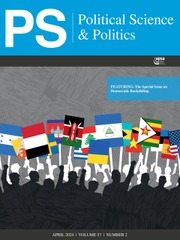Article contents
The Meyerhoff Incident: Simulating Bioterrorism in aNational Security Class
Published online by Cambridge University Press: 13 February 2006
Extract
Saturday night, downtown Baltimore, Maryland. A sold-out concertperformance at the Joseph B. Meyerhoff Symphony Hall. Unknowingly,the 2,400 members of the audience become victims of a bioterroristattack when an aerosol of plague (Y. pestis) issilently released. Over the course of the next 36 hours increasingnumbers of residents seek medical attention at area hospitals forcough and fever. By mid-morning on Monday some 300 persons withthese symptoms have received medical care; 17 of which have died.The State Health Department notifies the Center for Disease Control(CDC) and by mid-afternoon plague is confirmed first by the statelaboratory and subsequently by the CDC's Washington, D.C. lab.I would like to thank Carrie Vivian forher contributions to the development of this exercise and DenaOwens and PS's anonymous reviewers for theirinsightful comments and suggestions on this manuscript. Inaddition, I would like to express my gratitude to the formermayor of Westminster, Maryland, Kevin Dayhoff, and the emergencyresponders for their contributions to and participation in thisexercise.
Information
- Type
- THE TEACHER
- Information
- Copyright
- © 2006 The American Political Science Association
References
- 4
- Cited by

